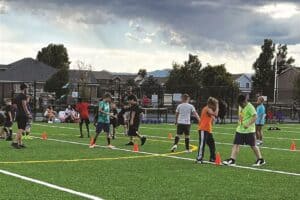One wildlife artist says, “When people ask me what my favorite painting that I have done is, I tell them ‘my next one.'” I hope that each article just gets more and more interesting.I promised to write more about the design of birds and a few of the many amazing facts there are about these incredibly interesting subjects.Last month, we talked about the flight and respiratory systems. This month, we’ll talk about migration and a few of the senses that aid in migration.One of the senses is the bird’s ability to use the earth’s magnetic field. Geographical variation and features change or distort the magnetic field in different areas in different ways. This creates a “map,” which the birds can use to navigate over incredibly long distances. For example, some time ago a storm petrel (a kind of seabird) was brought from its nesting burrow somewhere off the shores of England and taken to Boston, Mass., where it was released. It subsequently traversed the thousands of miles of featureless ocean to its exact burrow in 12 days, faster than a letter announcing its release could get there.Another example is that of racing or homing pigeons, which is closer to home. In fact, there are several people in this area of Falcon and Peyton who witness this marvel regularly. These are specially bred pigeons that are genetically “programmed” to find their way back home at high speed. The breeders are part of a club, which has a truck and a driver, and every so often they have a pigeon race.The truck driver drives around all the breeders’ houses early on the race morning and collects the pigeons, which are put in cages in the back of the truck. These cages are designed to open at the same time to release the pigeons for their race.After the driver has collected all the birds, he takes them to the area where the pigeons will start – about 300 miles away. The birds here in Falcon are taken out to Kansas. Once the driver arrives, the birds are all released at the same time, and they start their flight over the unknown prairie that they have never seen before.There is nothing familiar to the birds and there are no landmarks; they must find their way back to their home loft, flying nonstop from a place they’ve never been. The chance of being able to hit their tiny loft by random from 300 miles away is about one in a bazillion. They obviously have some complex navigational skills, for they get back to their home lofts in about six hours, according to a breeder in Peyton with whom I spoke.In summary, the birds are placed in a cage out of which they can’t see, driven 300 miles away, released and then travel back to their little 30’x 30′ loft at 50 miles an hour. That’s some navigation.And there are millions of other birds that must travel far greater distances without mistakes, for when you’re a tiny three-fourths-of-an-ounce bird, a mistake could be fatal.I hope these stories were interesting and amazing to you, and, although I didn’t get to discuss to a great extent how birds do this, I will attempt to do so in the next issue.Happy birding!







